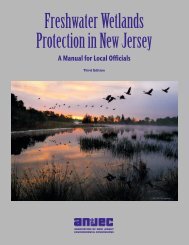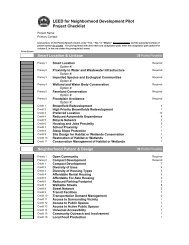REPORT
ANJEC Report Summer 2011
ANJEC Report Summer 2011
Create successful ePaper yourself
Turn your PDF publications into a flip-book with our unique Google optimized e-Paper software.
Compacted and depleted soils, collisions<br />
with bicycles and cars, vandalism, lack of<br />
access to outdoor spigots and “dog sprinkling”<br />
are some of the other challenges for<br />
a sapling trying to make it in the city.<br />
But tree planting is still worth the effort.<br />
The USDA Forest Service calculates that for<br />
every $1 invested in urban forest management,<br />
there is a return of $1.89 in benefits.<br />
For residents, merchants and property<br />
owners, the positive community<br />
effects can be priceless.<br />
For the past decade, the New Jersey Tree<br />
Foundation (NJTF) has been concentrating<br />
its planting efforts in urban areas, installing<br />
nearly 17,000 trees along streets and<br />
in public locations in places such as<br />
Camden, Newark, Jersey City, Neptune,<br />
Passaic and Plainfield. The organization’s<br />
philosophy is that trees “planted by<br />
residents, not for them” promotes environmental<br />
stewardship among residents<br />
and unifies communities.<br />
NJTF has trained thousands of residents<br />
as treekeepers, enlisting them in the<br />
planning and installation of new trees,<br />
and obtaining their commitment to care<br />
for the trees after planting. The result is an<br />
impressively high survival rate, partly due<br />
to proper planting and actual maintenance,<br />
but also to the sense of community<br />
ownership and protection that is<br />
“planted” along with the trees. The<br />
number of trained urban volunteers<br />
actually exceeds the number of trees<br />
installed, and that’s a significant contingent<br />
of stewards in the neighborhoods,<br />
looking out for their trees.<br />
Trees may fend for themselves in the<br />
forest, but in a developed area they<br />
require ongoing observation and maintenance<br />
to coexist with people, utility<br />
equipment and other entities that occupy<br />
public areas. A city cannot just plant trees.<br />
It must commit funds and staff to monitoring,<br />
tending, pruning and removing trees<br />
to minimize danger and protect its green<br />
infrastructure investments.<br />
This is a substantial commitment, and<br />
the State strongly encourages local governments<br />
and their shade tree commissions<br />
and public works departments to develop<br />
five-year Community Forestry Management<br />
Plans (CFMP) to insure responsible management<br />
of tree resources. NJTF has assisted<br />
cities by working with their tree boards and<br />
staff to craft CFMPs. An approved CFMP can<br />
help a municipality gain greater liability<br />
protection for damage caused by trees.<br />
Green infrastructure<br />
Trees serve as green stormwater infrastructure<br />
by intercepting precipitation as it<br />
falls, slowing and lowering the amount of<br />
runoff into storm sewers and swollen<br />
waterways. However, in cities it can be<br />
difficult to sacrifice enough sidewalk area to<br />
provide an adequate-sized planting bed for<br />
a large tree. As part of its Green City Clean<br />
Water Program, Philadelphia is investing in<br />
stormwater tree trenches for some new<br />
plantings to address two urban problems at<br />
once – onsite stormwater treatment, and<br />
providing enough space for large root<br />
systems without compromising<br />
aboveground surface stability.<br />
Tree trenches, which are large, strong,<br />
underground cages, provide support for the<br />
surface treatment (sidewalk, parking lot,<br />
plaza), offer uncompacted root growth<br />
areas, and direct local stormwater into the<br />
bottom of the trench where it can be<br />
absorbed by roots or percolate downward.<br />
Like most long-term infrastructure, the<br />
initial cost is high. But if a large tree is<br />
thought of as an investment in stormwater<br />
and air quality as well as a carbon sink and<br />
economic and social asset that can serve for<br />
50 or more years, it may start to sound like<br />
a bargain. Making cities and centers<br />
attractive to the masses will require these<br />
kinds of commitments.<br />
Resources:<br />
● ANJEC Resource Center –<br />
resourcecenter@anjec.org, (973) 539-7547<br />
● NJ Tree Foundation –<br />
www.newjerseytreefoundation.org<br />
● NJDEP Community Forestry Program –<br />
www.nj.gov/dep/parksandforests/forest/<br />
community<br />
● Green City Clean Water Program (tree<br />
trenches and other green stormwater<br />
techniques) – www.phillywatersheds.org<br />
20 ANJEC <strong>REPORT</strong> - Summer 2011












